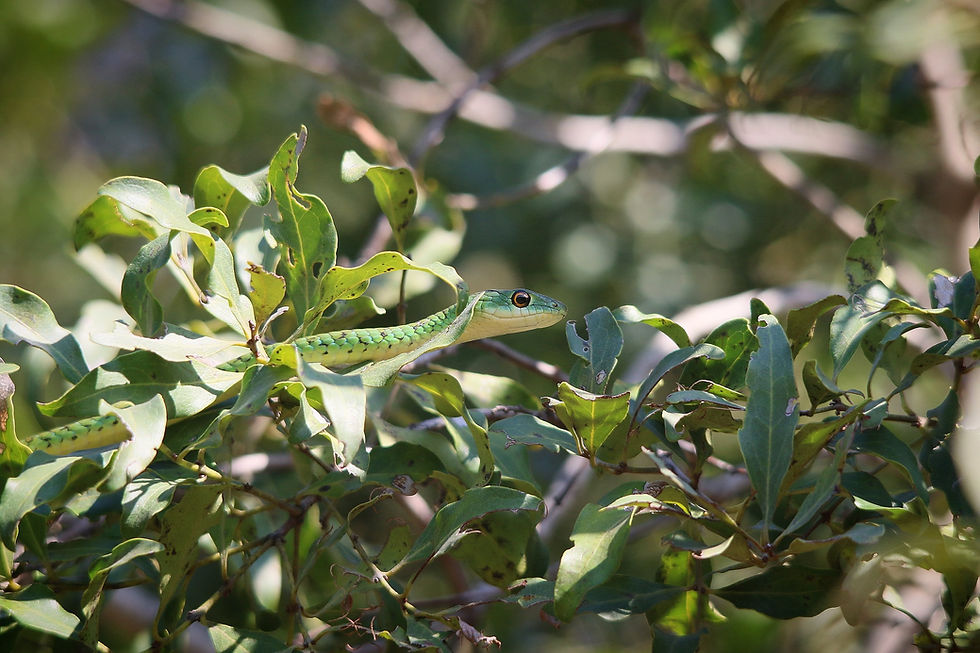Exploring the Spotted Bush Snake
In the heart of Africa's rich biodiversity, amidst the vibrant tapestry of its flora and fauna, the Spotted Bush Snake (Philothamnus semivariegatus) stands as a captivating testament to the wonders of nature.
Commonly known as the Variegated Bush Snake or Garden Snake, this non - venomous colubrid species is a true gem of the African wilderness.

Appearance and Distribution
With its slender physique, flat head, and a mesmerizing blend of bright green and olive hues adorned with striking black speckles, the Spotted Bush Snake is a sight to behold.
Its characteristic coloration provides excellent camouflage in the lush greenery of its natural habitat, making it a master of disguise in the trees of bush and forest areas.
This fascinating snake is no stranger to a broad geographical range, spanning from South Africa to Sudan, Uganda, and extending eastward to Tanzania.
In the northern regions, it explores the Kalahari and Northern Cape, reaching as far as Namaqualand in the west and Port Elizabeth in the east.

Habitat and Behavior
The Spotted Bush Snake's habitat of choice is the treetops, where it gracefully maneuvers through branches in search of its preferred prey: geckos, chameleons, and tree frogs.
This snake's adaptability extends to its climbing and swimming skills, highlighting its versatility in different terrains. Unlike some territorial reptiles, the Spotted Bush Snake is a wanderer, covering great distances in its quest for food.
Although sightings in suburban areas are rare due to their natural nervousness and quick escape instincts, lucky observers may catch a glimpse of this remarkable creature in the wild.
Reproduction and Life Cycle
Come summer, female Spotted Bush Snakes exhibit their remarkable reproductive abilities by laying 3 to 12 elongated eggs. The hatchlings, measuring around 25 cm in total length, mark the beginning of a new generation.
This cycle ensures the continued existence of these marvelous serpents in their diverse habitats.

Challenges in Captivity
While some enthusiasts attempt to keep Spotted Bush Snakes in captivity, their success is limited. These snakes prove challenging due to their nervous disposition, often refusing to feed on anything other than sympatric gecko species.
However, those who overcome these challenges find themselves rewarded with the opportunity to witness the unique behaviors of this elusive species up close.
Identification Tips
For those fortunate enough to encounter the Spotted Bush Snake in the wild, identifying it is made easier with some key characteristics:
Coloration: Vibrant green with black specks or stripes that run halfway down the body.
Size: Less than one meter long, slightly thinner than the average adult's pinky finger.

Conclusion
The Spotted Bush Snake holds a special place, captivating our imaginations and reminding us of the intricate beauty found in the untamed corners of our planet.
As we continue to explore and understand these fascinating creatures, we deepen our appreciation for the delicate balance that sustains life in the wild.
About The Author
Kyle Grobler is a passionate environmentalist and esteemed field guide from Potchefstroom. With an unparalleled love for nature, he boasts a vast collection of over 40,000 photos, illustrating his particular affinity for birds.
Known by many as the embodiment of a true bushman, Kyle has ventured through various South African game reserves and frequently explores the Vaal River's hidden treasures. As a new contributor to the Potch Gazette's environmental page, readers can anticipate immersive tales of Potchefstroom's natural wonders through Kyle's expert lens.
To see more from Kyle and his bush experiences you can also view his Youtube Channel here: Kyle Grobler Photography
More Reptile Stories
For more articles about reptiles you can click on the links below, there are so many great reptiles living amoungst us to discover and learn about as they play a major role in nature as we see it today.
World Reptile Day 2023: Click Here
African Rock Python and Impala: Click Here
Monitor Lizards: Click Here
Leopard Tortoise: Click Here
Blue Headed Tree Agama: Click Here
Puffadder: Click Here
Serrated Hinged Terrapin: Click Here
Brown House Snake: Click Here
Spotted Bush Snake: Click Here
Comments, Suggestions, Stories
Please do feel free to add any comments in our comments section below, we always love to hear about animals and experiences from our readers.








.jpeg)
